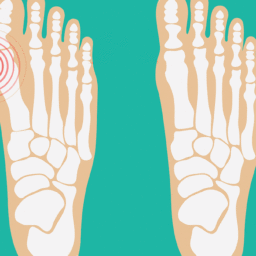
What are bunions and where do they come from?
We have all seen celebrities, like Oprah, walk down the red carpet in beautiful shoes, but displaying a large bunion. We question, “how did their feet get so bad?” Well, Oprah is not alone. Many women, and almost as many men, have developed bunions over the years, and it seems to be a problem mostly related to genetics (or hereditary factors; a parent or or grandparent) which only gets more aggravated by the shoes we wear. Bunions are a common condition that cause a bump to form on the big toe joint; creating irritation, redness and swelling. However, you do not have to continue suffering as bunion treatment options are available and effective.
Why do we get bunions?
There are many mechanical reasons as to why we develop bunions. The first and foremost is a flat arch. As the arch flattens out, the first metatarsal (or big toe joint) loses support and starts to deviate from its neighboring metatarsals, causing a protrusion on the inside of the foot. This protrusion then rubs upon the shoe wall and begins to calcify even thicker, thus dispelling the myth that bunions are more like calluses or soft tissue growths on the feet. As these bones deviate, the big toe begins to turn towards the second toe, causing a hallux abducto valgus deformity.
The second known cause for bunions is from the geometric shape of our tarsal bones (the bones of the arch of the foot). Many have argued that people in this category may have a gene distantly related to that of our primate “cousins.” The shape of this bone, otherwise known as the cuneiform, can allow for destabilization of the first metatarsal, and thus cause severe deformity, whether you have a high or low arch. This can also result in a rotation of the bone or “sliding off of the knuckle bone,” which leaves the joint even more deformed.
Hence, knowing how a bunion forms lends itself to knowing the best way to correct it. Some bunions are painful, and others are not, which is oftentimes related to the type of shoes being worn. However, what people don’t realize is that if you leave a bunion existing for too long, it can become arthritic around the big toe joint, which is painful and can lead to a more involved treatment.
Treatment for Bunions
Conservative bunion treatment always involves injectable medications, orthotics, or arch supports with shoe modifications, which may be as simple as shoes that are wider. Unfortunately, many patients resort to exclusively wearing sandals as their treatment, which can restrict their lifestyle and may still lead to disfiguring deformities and arthritis (believe it or not, more hammertoes come from bunions than from other causes).
Here at Certified Foot & Ankle Specialists, we excel in delivering the best surgical care. For many with a stubborn bunion, the only good bunion treatment is surgical correction because the patient has already tried many shoe options. We always explain the certain risks, such as recurrence, infection, nerve injury, delayed bone healing. Surgical treatment of a bunion may range from a simple bunionectomy, or shaving of the bump of bone in mild cases. Or, in more advanced cases, there is precision cutting of the bone to shift the metatarsal back in place. In recent years the industry has developed advanced surgical techniques and fixation to allow for better outcomes as well as quicker recovery periods.
Most popular treatment techniques
The Silver bunionectomy, otherwise known as the McBride bunionectomy is an excision of the bump with shaving down the bone until smooth. The Austin bunionectomy, which traditionally will create a V cut across the metatarsal head and shift it back into place. This reduces the relative deviation and bump as well. This is usually corrected with a screw, and the big toe will generally straighten out naturally. In cases where the big toe needs more correction, the Akin bunionectomy technique may be added. This removes a small wedge of bone mediately at the big toe level and is fixated with a staple or screw which straightens the big toe.
For severe bunion treatment, we perform a more proximal wedge cut toward the base of the metatarsal (knuckle bone). We also perform Lapidus bunionectomies, which create fusion of the joint at the arch level with equally dramatic correction of the deviated first metatarsal. This is then fixated with screws or plates for stability. Again, modern day fixation and surgical techniques have enhanced the stability and success of even the most complicated bunionectomy procedures.
At Certified Foot & Ankle Specialists, we also have perfected the technique of minimally invasive surgery (or MIS) for the correction of severe bunions. This involves a cut through the bone and fixation with either screws or a plate, but the difference is that the incisions are very small and there is less soft tissue disruption, making recovery easier on the patient. This has become a popular and highly favored bunion treatment, especially for patients who desire less scarring.
The results are exceptional in the visual correction that is achieved. Patients can get back to wearing normal shoes and return to a normal active lifestyle within 6 to 8 weeks after. Patients seem to appreciate the greatly improved appearance of the foot, which is sometimes the primary complaint. Hence, minimally invasive surgery is the wave of the future.
So before you call up your relatives to complain about the bad feet you inherited, consider these tried-and-true techniques for complete correction of your bunion deformity.
By Jason LeVitre, DPM, FACAS




